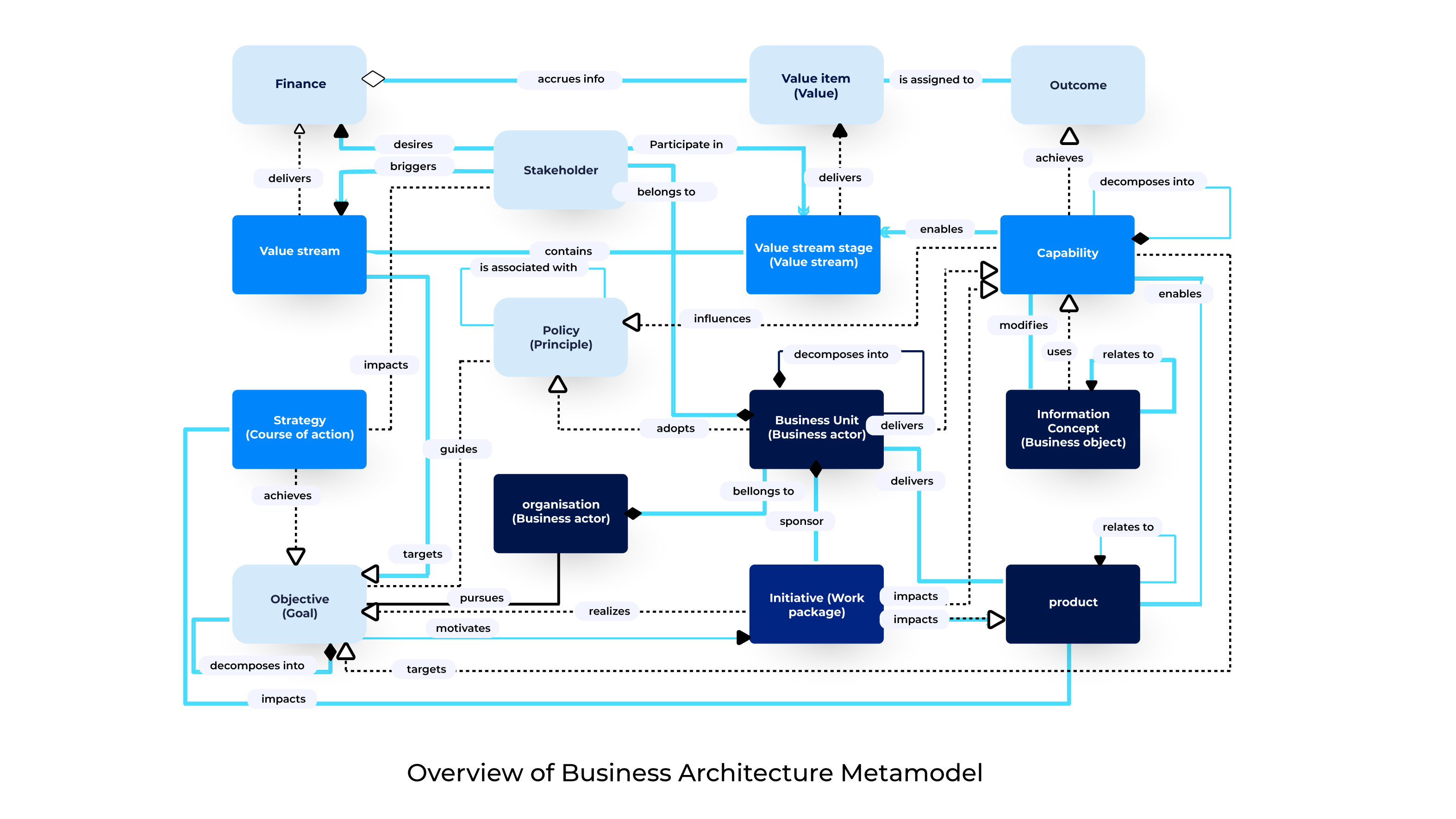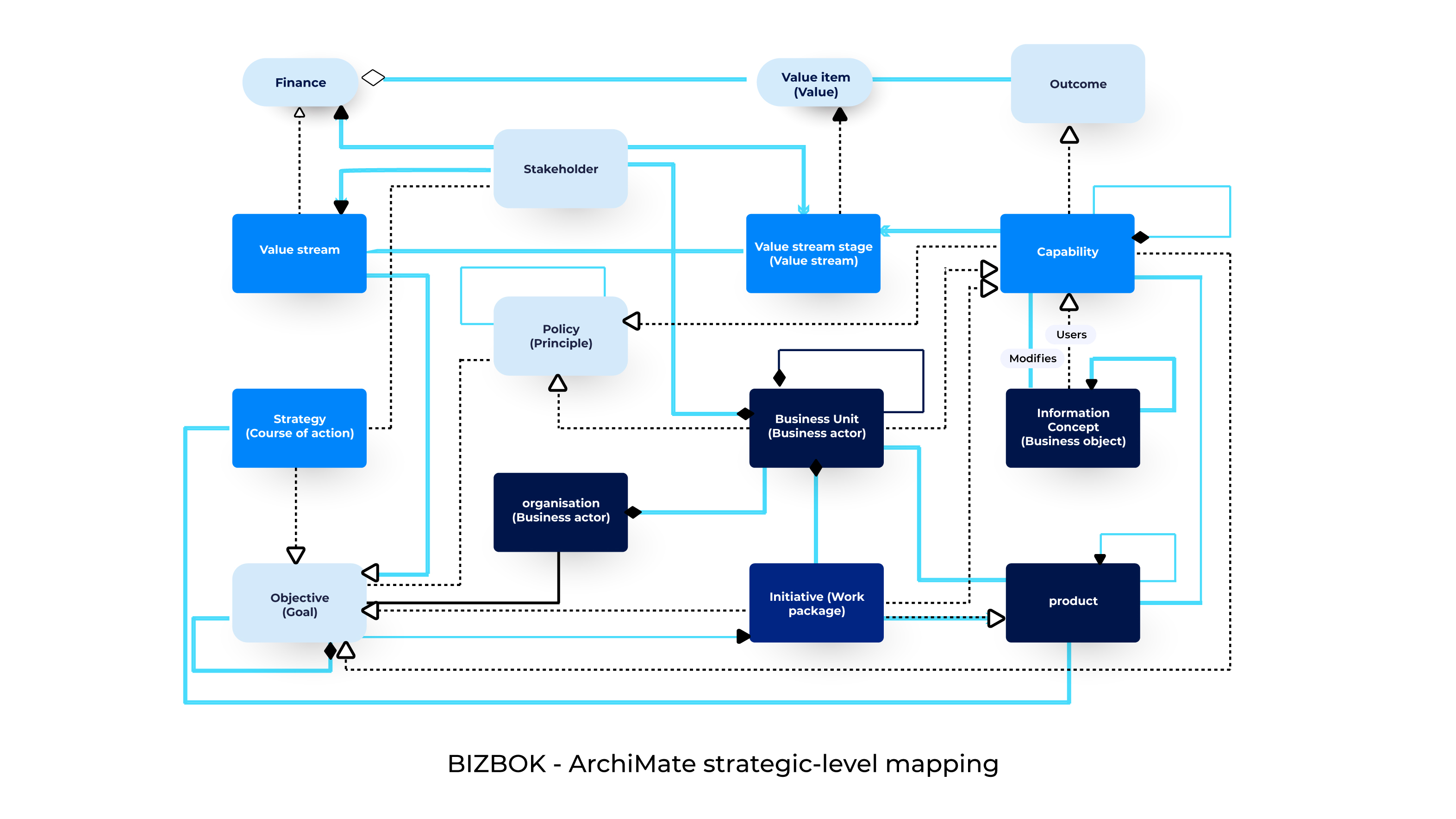Business Architecture Redefined: Mapping BIZBOK® to ArchiMate®

The Business Architecture Body of Knowledge (BIZBOK®) has become a widely used reference for business architects worldwide. ArchiMate®, in parallel, provides an open standard to represent enterprise architecture with a clear, consistent notation.
Mapping BIZBOK to ArchiMate bridges these two approaches, enabling architects to connect business architecture concepts to the broader scope of enterprise architecture. This mapping helps teams align definitions, avoid concept drift, and keep business architecture directly connected to planning, change, and investment decisions.
In this article, we explain how BIZBOK® can be expressed in ArchiMate®, highlight key mapping examples, and show why this integration strengthens both strategic and operational modeling.
What is BIZBOK®?
Since the foundation of the Business Architecture Guild and publishing version 1 of Business Architecture Body of Knowledge (BIZBOK®) in 2011, the best practices have become a popular set of guidelines and techniques for practicing business architects.
This metamodel provides a core set of concepts for expressing business architecture in the sense that BIZBOK® defines it. The ArchiMate® modeling language for enterprise architecture, first published in 2004 and established as an Open Group standard in 2009, also covers business architecture but has a wider scope.
Moreover, it offers a notation as well as a metamodel, so you can write down your architecture models in a standardized way that your fellow architects understand.
Now, wouldn’t it be great if you could express BIZBOK®-based business architecture in ArchiMate? That would allow business architects to benefit from the well-established tool support for the language in expressing their business architecture artifacts.
Moreover, it would let business architects easily connect these architectures to this broader and deeper scope of enterprise architecture.
The ArchiMate® language was explicitly designed with such relations to other languages and metamodels in mind. It therefore provides a bridge to languages like UML and BPMN, with equivalent concepts. For instance, the ArchiMate® ‘Application Component’ concept equates with the UML ‘Component’ concept.
Conversely, if we don’t link business architecture with the rest of enterprise architecture, it risks being a stand-alone discipline that can't show measurable value.
By showing how those concepts are underpinned by more concrete elements like those mentioned above, they become much more tangible and understandable for non-architects.
Concept Mapping: BIZBOK® and ArchiMate®
We have created the mapping in the figure below to support collaboration between the architecture design disciplines. The first picture shows the BIZBOK® metamodel version 3 and the second picture shows the applicable ArchiMate® 3.2 concepts and relationships. If the concept name differs, the ArchiMate® concept name was add in brackets.


From the ArchiMate® language, we use motivation, strategy, business, implementation, and migration elements.
The mapping between two conceptual universes is rarely 1:1. Concepts from different standards should be matched based on their definitions rather than their names. Fortunately, in this case many of the metamodel terms are already quite close.
Some of the BIZBOK® concepts could be expressed with different ArchiMate® elements though. For example, the ‘Stakeholder’ concept in BIZBOK® can be used to express someone with an interest or concern, just like in ArchiMate®.
However, in BIZBOK® it can also have an operational role, e.g., triggering a value stream. In ArchiMate®, you can better express such operational roles using the ‘Business Role’ concept. Although there are a few different options, the mapping above works well in practice and is a good starting point for your business architecture modeling efforts.
Hierarchical Levels in Concept Mapping
In this mapping, you may notice that ArchiMate uses a single concept at different hierarchy levels. For instance, the BIZBOK® ‘Organization’ and ‘Business Unit’ concepts are both expressed with an ArchiMate ‘Business Actor’ in the second mapping, one composed of the other.
In this mapping, you may notice that ArchiMate® uses a single concept at different hierarchy levels. For instance, the BIZBOK® ‘Organization’ and ‘Business Unit’ concepts are both expressed with an ArchiMate® ‘Business Actor’ in the second mapping, one composed of the other.
As you can imagine, an organizational structure may include layers such as departments with business units, and teams within those departments.
The same pattern is shown by BIZBOK®’s ‘Value Proposition’ and ‘Value Item’, both mapped to ArchiMate®’s ‘Value’ concept, and by ‘Value Stream’ and ‘Value Stream Stage’, both expressed as ‘Value Stream’ in ArchiMate®.
Moreover, unlike the more strictly defined BIZBOK®® concept, you can even use an ArchiMate® ‘Value Stream’ to model an entire value chain, thus linking your business architecture to your business model in the economic sense.
Such hierarchical levels occur in many other areas too, e.g. business process decomposition or application structure. For this reason, ArchiMate® does not have any built-in, fixed hierarchies.
Rather, it allows arbitrary composition and aggregation levels between elements of the same type. That flexibility provides you with yet another way to drill down from high-level, strategic views of the enterprise into progressively more detailed operational models.
However, if you want to map the BIZBOK®® concepts more closely to ArchiMate®, you can use the language customization mechanisms outlined in Chap. 15 of the ArchiMate® specification to create custom specializations for these different hierarchical levels. These could even have a custom notation.
From Business Architecture to operating model
From the concepts in this mapping, you can drill down into your enterprise's operating model. More concrete concepts for that operational level can be linked with a Realization relationship to their more abstract counterparts in a business architecture model. For instance, ArchiMate® Business Processes can realize a Value Stream stage, and Business Functions can realize a Capability.
From this operating model, we can drill down deeper towards the implementation, for instance, to express that a Business Process is automated, modeling its realization by an Application Process performed by some Application Component. That way, you can drill down from high-level business drivers and motivation via your business architecture into the underlying operating model as expressed in elements like business services and processes, applications, IT infrastructure, and physical technology.
Such a line of sight provides essential business insights, helping you set investment priorities, analyze operational risks, assess regulatory compliance, foster innovation, and much more.
As you can see from the above, the ArchiMate® language is an excellent way to express your BIZBOK® business architectures and relate them to other architecture and design domains. See also our eBook on Capability-based Planning for this.
Good tooling helps you work with these models at scale –– building, analyzing, and sharing them as part of everyday architecture work.
If you require support in mapping BIZBOK® metamodel details to ArchiMate®, please contact our experts.
FAQs
BIZBOK® provides a core set of concepts, guidelines, and techniques for expressing business architecture as defined by the Business Architecture Guild. Its metamodel outlines key elements such as capabilities, value streams, stakeholders, value propositions, and organizational structures, offering a structured way for business architects to describe how the business creates and delivers value.
ArchiMate® supports BIZBOK® concepts by offering a standardized modeling language and notation that can express those same business architecture elements within a broader enterprise architecture context. It includes motivation, strategy, business, implementation, and migration elements that correspond to many of the BIZBOK® metamodel concepts. It also allows for hierarchical modeling, making it possible to represent different levels of detail—such as capabilities, value streams, and organizational units—in a consistent way.
Mapping BIZBOK® to ArchiMate® makes business architecture easier to connect to the rest of enterprise architecture. It ensures that abstract concepts like capabilities and value streams can be linked to more concrete elements such as processes, applications, and roles. This helps architects avoid business architecture becoming a stand-alone discipline, improves understanding for non-architects, and provides a clearer line of sight from strategic intent to operational models and implementation.



